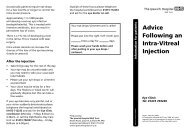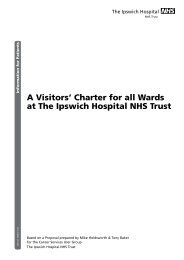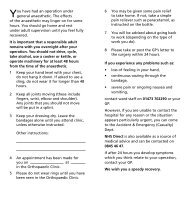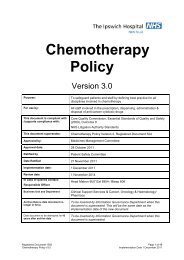Hand Hygiene Policy Version 2.0 - Ipswich Hospital
Hand Hygiene Policy Version 2.0 - Ipswich Hospital
Hand Hygiene Policy Version 2.0 - Ipswich Hospital
Create successful ePaper yourself
Turn your PDF publications into a flip-book with our unique Google optimized e-Paper software.
SECTION 1 - INTRODUCTION<br />
1.1 <strong>Policy</strong> Statement and Rationale<br />
The <strong>Ipswich</strong> <strong>Hospital</strong> NHS Trust is committed to ensuring that patient safety including the<br />
prevention and control of infection is paramount at all times. This policy describes the<br />
precautions to be taken when caring for all patients regardless of whether they have been<br />
diagnosed with a particular infection or carriage of a specific organism.<br />
The overall objective is to ensure that there is a Trust-wide approach to hand hygiene that<br />
ensures that the risk of transmission of infection is minimised at all times, which is<br />
communicated to and available to all staff, patients, their families and carers and the public.<br />
1.2 Key Principles<br />
<strong>Hand</strong> hygiene<br />
Use of soap and running water<br />
Use of alcohol hand rub<br />
1.3 Background Information<br />
During the past two decades, healthcare associated infections (HCAI) have become a<br />
significant threat to patient safety. The technological advances made in the treatment of<br />
many diseases and disorders is often undermined by the transmission of infections within<br />
healthcare settings, particularly those caused by antimicrobial-resistant strains of diseasecausing<br />
microorganisms that are now endemic in many healthcare environments. The<br />
financial and personal cost of these infections, in terms of the economic consequences to<br />
the NHS and the physical, social and psychological costs to patients and their relatives,<br />
have increased both government and public awareness of the risks associated with<br />
healthcare interventions, especially that of acquiring a new infection.<br />
Although not all HCAIs can be prevented, many can. Clinical effectiveness, ie, using<br />
prevention measures that are based on reliable evidence of efficacy, is a core component<br />
of an effective strategy designed to protect patients from the risk of infection.<br />
1.4 Definitions<br />
HCAI Healthcare Associated Infection<br />
NHS National Health Service<br />
HICC <strong>Hospital</strong> Infection Control Committee<br />
PASA Procurement and Supplies Agency<br />
IPC Infection Prevention and Control<br />
SECTION 2 – DUTIES AND RESPONSIBILITIES<br />
2.1 Chief Executive<br />
The Chief Executive has ultimate accountability for all aspects of infection prevention and<br />
control and for ensuring appropriate action is taken to promote low levels of HCAI. He/she<br />
will be responsible for ensuring that the necessary resources and management framework<br />
are available and for managing any high level risks to achieve this policy.<br />
2.2 Director of Infection Prevention and Control (DIPC)<br />
DIPC is appointed by the Trust Board and reports directly to the Chief Executive and the<br />
Board. He/she is accountable to the Board for:<br />
overseeing local control of infection policies and their implementation;<br />
Registered Document 472 Page 4 of 15<br />
<strong>Hand</strong> <strong>Hygiene</strong> <strong>Policy</strong> v<strong>2.0</strong> Implementation Date 25 February 2009

















